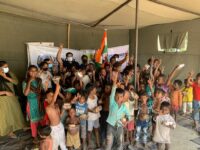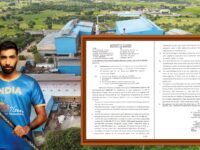Mumbai: High levels of E. coli, faecal matter found Santacruz chawl`s water

Residents of Subramanium chawl in Santacruz have been experiencing a host of symptoms such as loose motions, rashes, sleeplessness, vomiting, ringworm and migraines owing to the presence of E. coli and faecal matter in their water. Locals have been compelled to use hand pumps due to low water pressure. mid-day, on August 8, sent samples of water from the chawl for testing. Residents store the liquid in drums and wait for the black grain to settle down so they can use it for bathing and washing clothes. According to the lab results, which arrived on August 14, there were 300 units of E. coli in one millilitre of the water tested. While E. coli is not uncommon, according to microbiologists, the presence of faecal matter in water supplied by the civic body is almost unheard of.
According to experts, in general, out of approximately 50 water samples containing E. coli, only two will have 300, which is usually the amount seen in the water that gushes out of a tap in the first five minutes. “However, in this case, even after one hour of flow, the plate is full of E. coli,” said Rahul Yadav, a microbiologist at Agrobiomics Lab.
Dr Hemalata Arora of Nanavati Hospital said that when the amount of bacteria in water is high, it can enter the intestines as it will not be destroyed by one’s stomach acid.
Rajkumari Jaiswal, who has been suffering from low blood pressure; (right) Arjun Lokhande, who was hospitalised due to low haemoglobin and red blood cell count
Rajkumari Jaiswal, a 60-year-old resident, said her bones ache while pumping water for an hour reports and that as the water got dirtier, her trips to the doctor over low blood pressure-related issues have increased. The senior citizen lives alone and says she barely manages to put food on her table due to medical expenses and most of her money goes into buying packaged drinking water. According to Dr Arora, contamination due to the presence of E. coli and faecal matter in water can cause blood pressure to drop.
Arjun Lokhande, another resident, was admitted to the hospital for a week due to low haemoglobin and red blood cell count. “I almost died and was shivering in a state of shock. Luckily I was taken to hospital in time,” he said. Suman Mishra, like many other residents, complained of constant rashes, which rob him of sleep. Another chawl resident Mamta Gupta complained to mid-day of experiencing loose motions, excruciating stomach pain and nausea.
Residents alleged that when the BMC implements a change after a certain party holds a morcha demanding that the problem be fixed, a rival party will physically break the pipes so that the first party does not get the credit.
Dr Vinay Dhir, a gastroenterologist at SL Raheja Hospital, said hydration is key in such cases, as the gastroenteritis bacteria enter the intestines causing inflammation, which leads to water excretion. However, Nitin Kamble, who is in charge of the community toilets at the site, said, “When the doctor tells us to hydrate, we say that it usually takes an hour to pump out dirty black water in the hope that cleaner water comes out. When it does, it happens only for 15 minutes. When the news of a hand pump yielding clean water spreads like wildfire, people line up at the spot in question. We have to walk for 20 minutes to search for a tap, and if even that doesn`t work out, the last resort is bottled water, which we use to even shower.
Dr Arora said bacteria can enter the mouth and eyes via small droplets while washing and that repeated instances of diarrhoea can cause growth stunting in children.
Irate over the impurities found in their water, residents have demanded that they be compensated as they have been paying their water bills.
Kamble, meanwhile, suggested that water recycling machine be set up to convert black water into clean water fit for purposes other than drinking. “Residents must be given a legal stake in decision making to solve problems like these as they are well aware of the topography and the minor details of the problem,” he said.
He asks “If slums on hills receive clean water with a robust force why not us? “
Taking cognisance of mid-day’s August 9 and 11 reports on the residents` water woes, Satish Bagdire, medical officer of H East ward, on August 17 said, “I have informed the health post to do a survey in the affected area and requested the assistant engineer of the water works department to look into this matter and solve it on an urgent basis.”
BMC officials subsequently visited the spot to install cameras and sensors to detect any defects in the pipes that bring water to the chawl. Currently, the pipes go through the Vakola nullah and are attached to the nearest functioning BMC pump, which is 250 metres away from the settlement. Nullah water is known to seep into the pipes. Two days after this newspaper`s second report of the situation, the BMC completed the insertion of a two-inch booster as a temporary solution.
A BMC officer claimed that until there is a permanent solution, this measure would result in the provision of clean water with a powerful force. However, a week since it was installed, residents say the situation has not improved. Civic officials said a permanent solution will be initiated after the monsoon where a new 12-inch pipe will lead directly to the slum after a few houses are relocated to make way for it.
While civic officials told mid-day that residents should have complained about the issue earlier, a photojournalist of this newspaper retrieved a complaint given by Viren Kanojia, a resident, given to the hydraulics department on July 12 this year as well as letters to the department dating back to 2021.
National Convener at the Jan Swasthya NGO, Dr Abhay Shukla said, “This is a classic case of the lopsided way in which Mumbai is developing. Medical officers and the water works department are bearing the brunt of a larger urban planning fault.”
Mathew Mattam, who has been working in the field of clean water and sanitation for three decades, was outraged by the water situation at the Santacruz chawl. “This is an outright violation of human rights,” he said.
300
No. of units of E. coli found per 100ml of water

Atul Tiwari is a seasoned journalist at Mumbai Times, specializing in city news, culture, and human-interest stories. With a knack for uncovering compelling narratives, Atul brings Mumbai’s vibrant spirit to life through his writing.





